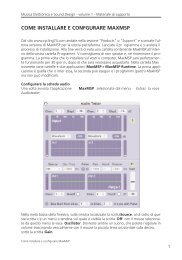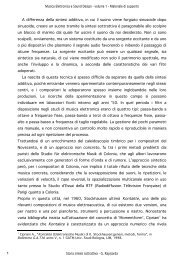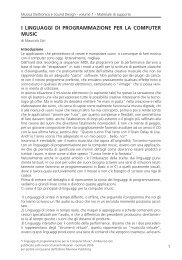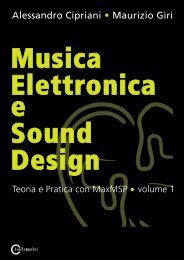programming with max/msp - Virtual Sound
programming with max/msp - Virtual Sound
programming with max/msp - Virtual Sound
You also want an ePaper? Increase the reach of your titles
YUMPU automatically turns print PDFs into web optimized ePapers that Google loves.
1.2<br />
10<br />
Theory<br />
time (by measuring the pressure at a single location as a function of time). For<br />
example, we can imagine that if we were located at a specific point in space,<br />
we might observe a series of condensations and rarefactions of the air around<br />
us, as in Figure 1.8.<br />
pressure<br />
� ��<br />
���<br />
���<br />
� �<br />
Paragraph 1.2 - Frequency, amplitude, and waveform<br />
Fig.1.8 A graphical representation of compression and rarefaction<br />
� �<br />
At time t -1 , which occurs immediately before t 0, the air pressure has its normal<br />
value, since the cyclic disturbance has not yet reached our point of observation.<br />
At instant t 0, the disturbance arrives at our observation point, pressure starts to<br />
rise, reaches a <strong>max</strong>imum value at time t 1 , and then decreases until it returns to<br />
normal at time t 2 . It continues to decline, reaching its minimum value at t 3 , after<br />
which pressure returns to its normal value at t 4 ; the pattern then repeats. What<br />
has been described is a phenomenon called a cycle, and an event that always<br />
repeats in this way is called periodic. 8 The time required to complete a cycle is<br />
said to be the period of the wave, which is indicated by the symbol T and is<br />
measured in seconds (s) or in milliseconds (ms). The number of cycles that are<br />
completed in a second is defined as frequency, and is measured in hertz (Hz) or<br />
cycles per second (cps).<br />
If, for example, a sound wave has period T = 0.01s (1/100 of a second), its frequency<br />
will be 1/T = 1/0.01 = 100 Hz (or 100 cycles per second).”(ibid)<br />
While examining Figure 1.9, listen to the sounds of Interactive Example 1A. 9<br />
We can see (and hear) that increasing the number of cycles per second (Hz)<br />
corresponds to making a sound higher in pitch.<br />
8 Mathematically a waveform is said to be periodic if it is repeated regularly for an infinite time. In<br />
the practice of music, of course, we can satisfy ourselves <strong>with</strong> periods much shorter than infinity!<br />
We will say that a wave is “musically periodic” when it displays enough regularity to induce a<br />
perception of pitch that corresponds to the period of the wave. We’ll discuss this issue in more<br />
detail in Chapter 2.<br />
9 Please note that interactive examples and other supporting materials to the book can be found<br />
on the website.<br />
from “Electronic Music and <strong>Sound</strong> Design” Vol. 1 by Alessandro Cipriani and Maurizio Giri<br />
© ConTempoNet 2010 - All rights reserved<br />
� �<br />
� �<br />
� �







